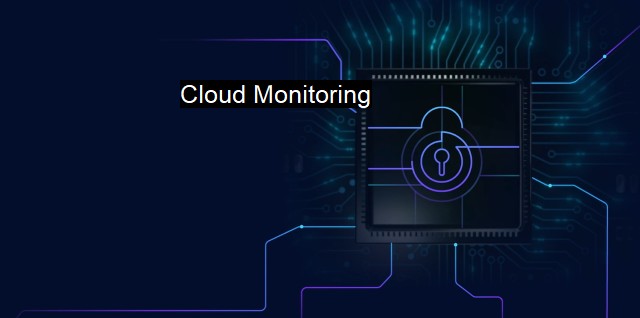What is Cloud Monitoring?
Securing the Cloud Landscape: The Importance of Cloud Monitoring for Cyber Threats and Antivirus Activities
Cloud monitoring denotes the process by which businesses and IT developers keep track of the resources in a cloud infrastructure such as websites, servers, databases, and virtual networks. This process leverages several automated criteria such as uptime, response time, CPU and RAM usage to ensure the optimal performance of a cloud-based project. Owing to the dynamic and complex nature of the cloud, networks operating remotely on cloud servers require constant vigilance to control and optimize resources.In the modern era, where cyber threats lurch in every corner of the digital world, cybersecurity has emerged as an essential component in facilitating good business practice and data management. That's where the role of cloud monitoring in the context of cybersecurity and antivirus comes into the picture.
When it comes to cybersecurity, cloud monitoring works towards identifying and rectifying security vulnerabilities while negating any risks of data loss or leakage. It regularly inspects the cloud environment to detect any unauthorized activities or access, malicious patterns or sequences, or any form of web-based threats. It continuously monitors and analyses all the applications and services running on a cloud infrastructure and alerts the system administrators to suspicious activities that breach set protocols, helping them resolve such issues before they escalate.
Cloud monitoring system helps in enforcing protocols and substance procedures for security applications such as antiviruses. An antivirus program setup usually involves scanning to detect potential threats such as malware, Trojans, and viruses hidden in various forms such as rogue software or phishing attachments. Such malicious entities can cause harm to the system unless detected and quarantined in time. Cloud monitoring ensures this by conducting regular audits, thereby enabling the antivirus system's effective response to any threats.
Cybersecurity in the cloud presents an increasingly challenging environment as hackers continue to launch refined attacks to exploit vulnerabilities. Therefore, an excellent cloud monitoring management should not just be focused on resource usage and system performance but also adapt to new forms of attacks and cyber threats. Companies need to modernize their threat-detection features regularly, often involving integrating specialised tools such as machine learning and AI to detect unusual patterns and linking anomalies that could allude to specific cyber threats.
Several top-tier businesses employ cloud-based application performance monitoring (APM) tools combining user experience insights, transaction tracing, synthetic monitoring advanced analytics to predict issues, identify bottlenecks, and analyze trends. This approach enables companies to take a proactive approach to threat detection, rather than merely react to cyber threats and attacks.
With developments such as the Internet of Things (IoT), and increasing interconnections and dependencies between systems changing the landscape of IT infrastructure, security loopholes find new gateways. The evolving cyber world requires advancing adaptive security architectures. To meet these challenges, enterprises need to understand that effective cloud monitoring demands comprehensive, high-quality, and real-time data concerning their network's health and security.
Cloud monitoring in the context of cybersecurity and antivirus is a vital aspect of network management. It is not just about ensuring system performance and resource optimization but is paramount at maintaining security and confidentiality in a modern business environment. The whole purpose lies in the timely detection of vulnerabilities, mitigation of threats, protection against data breaches and enabling efficient antivirus responses. With the cloud becoming a primary framework for hosting services and applications, the significance of efficient antivirus and cybersecurity in the cloud monitoring only stands to grow.

Cloud Monitoring FAQs
What is cloud monitoring?
Cloud monitoring is the process of monitoring and analyzing the activity and performance of cloud environments, such as cloud-based applications, infrastructure, and services. It involves collecting data about the usage and behavior of these resources, and using that data to identify potential security threats and performance issues.What are the benefits of cloud monitoring for cybersecurity and antivirus?
Cloud monitoring can help improve cybersecurity and antivirus by providing real-time visibility into potential security threats and vulnerabilities in cloud environments. By monitoring user activity and network traffic, cloud monitoring tools can detect suspicious behavior, such as unauthorized access or data exfiltration, and alert security teams to take action. Additionally, cloud monitoring can help identify performance issues that may affect the availability and reliability of antivirus software and other security tools.What types of data do cloud monitoring tools collect?
Cloud monitoring tools can collect a variety of data about cloud environments, including user activity logs, network traffic logs, system performance metrics (such as CPU usage and memory usage), and application logs. Some tools may also collect information about the configuration of cloud resources, such as firewalls and access controls.What are some key features to look for in a cloud monitoring solution?
When selecting a cloud monitoring solution, it's important to look for features such as real-time monitoring, automated alerting, customizable dashboards and reports, and integration with other security tools. It's also important to consider the scalability and flexibility of the solution, and whether it can support the specific cloud environments and applications used by your organization. Finally, make sure to evaluate the quality and responsiveness of the vendor's customer support and technical assistance.| | A | | | B | | | C | | | D | | | E | | | F | | | G | | | H | | | I | | | J | | | K | | | L | | | M | |
| | N | | | O | | | P | | | Q | | | R | | | S | | | T | | | U | | | V | | | W | | | X | | | Y | | | Z | |
| | 1 | | | 2 | | | 3 | | | 4 | | | 7 | | | 8 | | |||||||